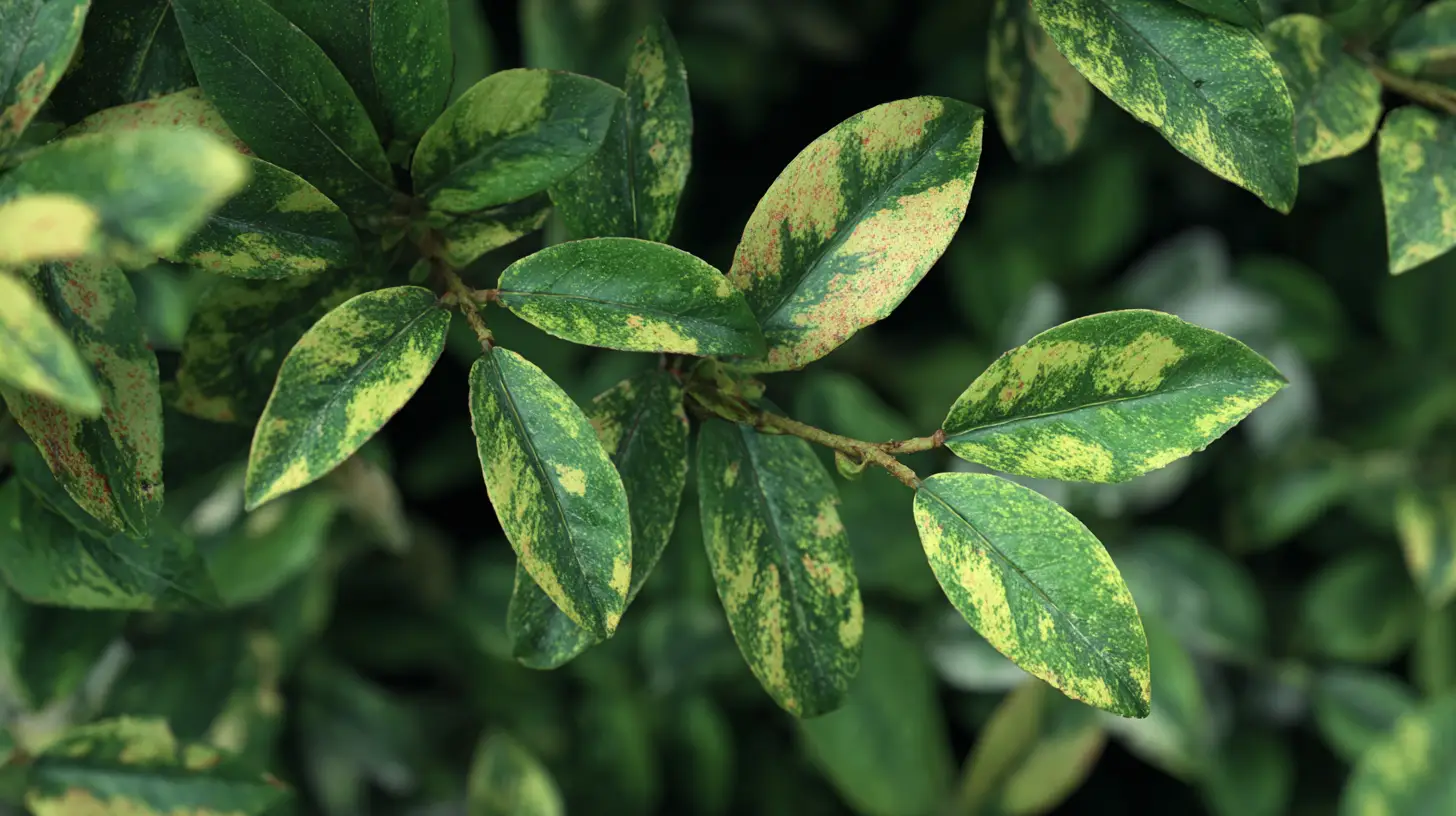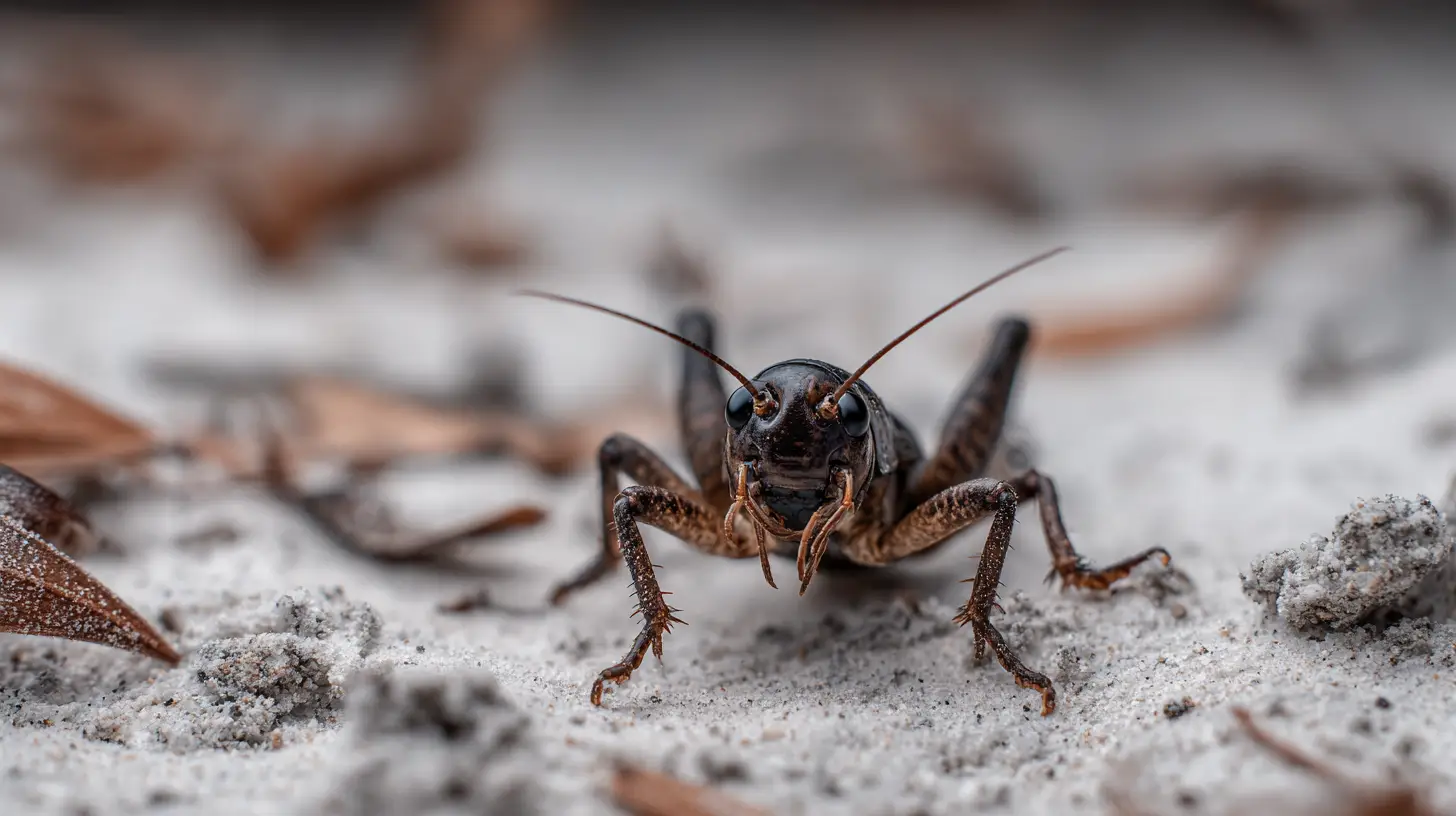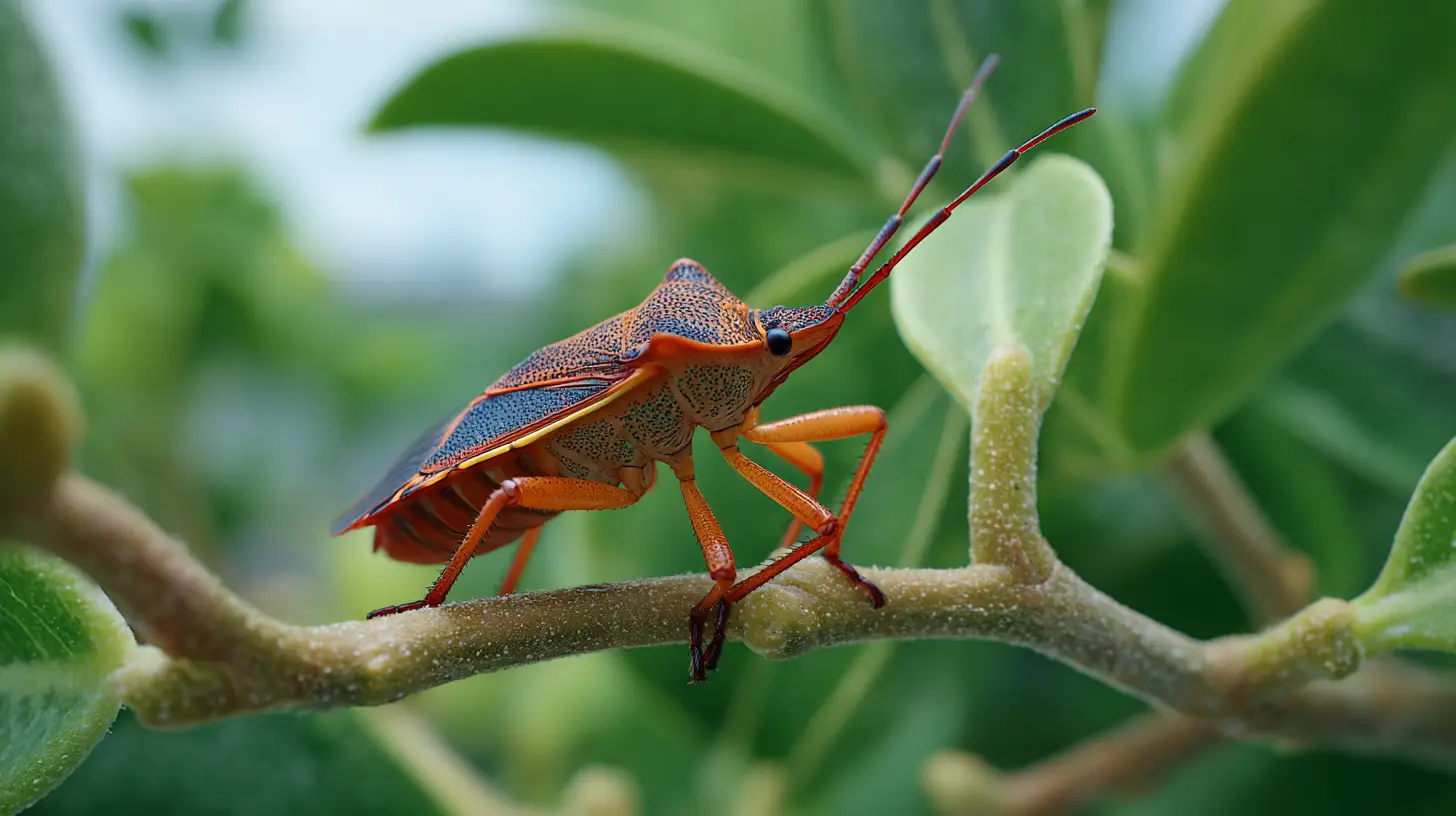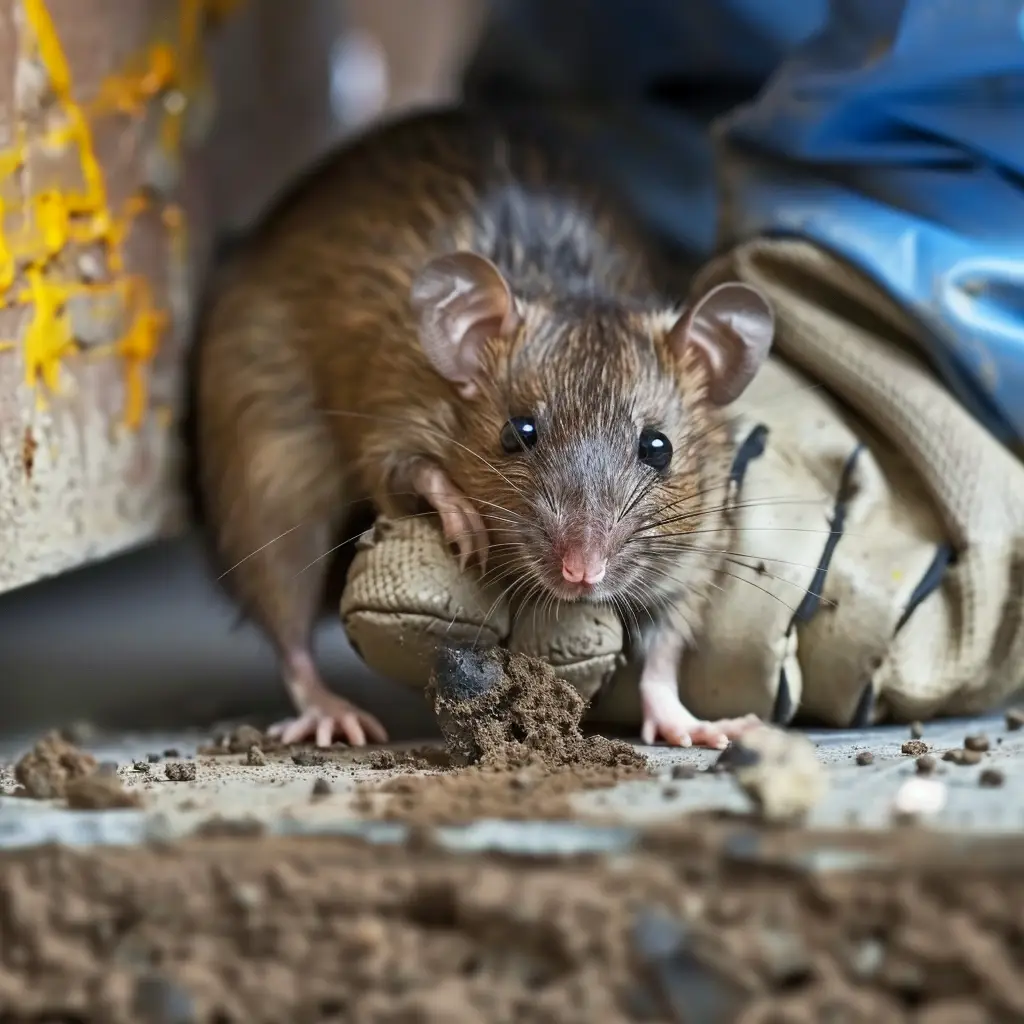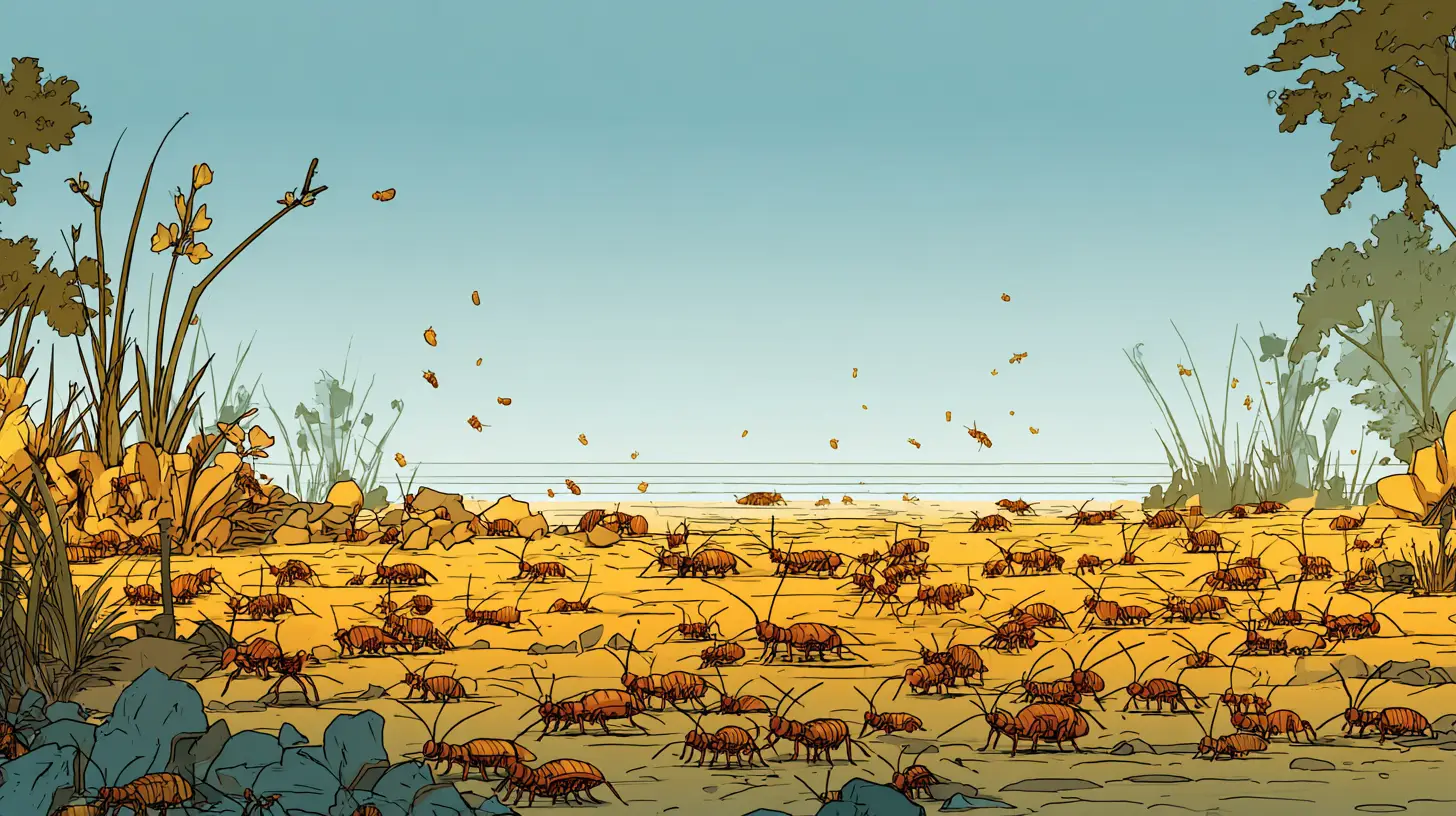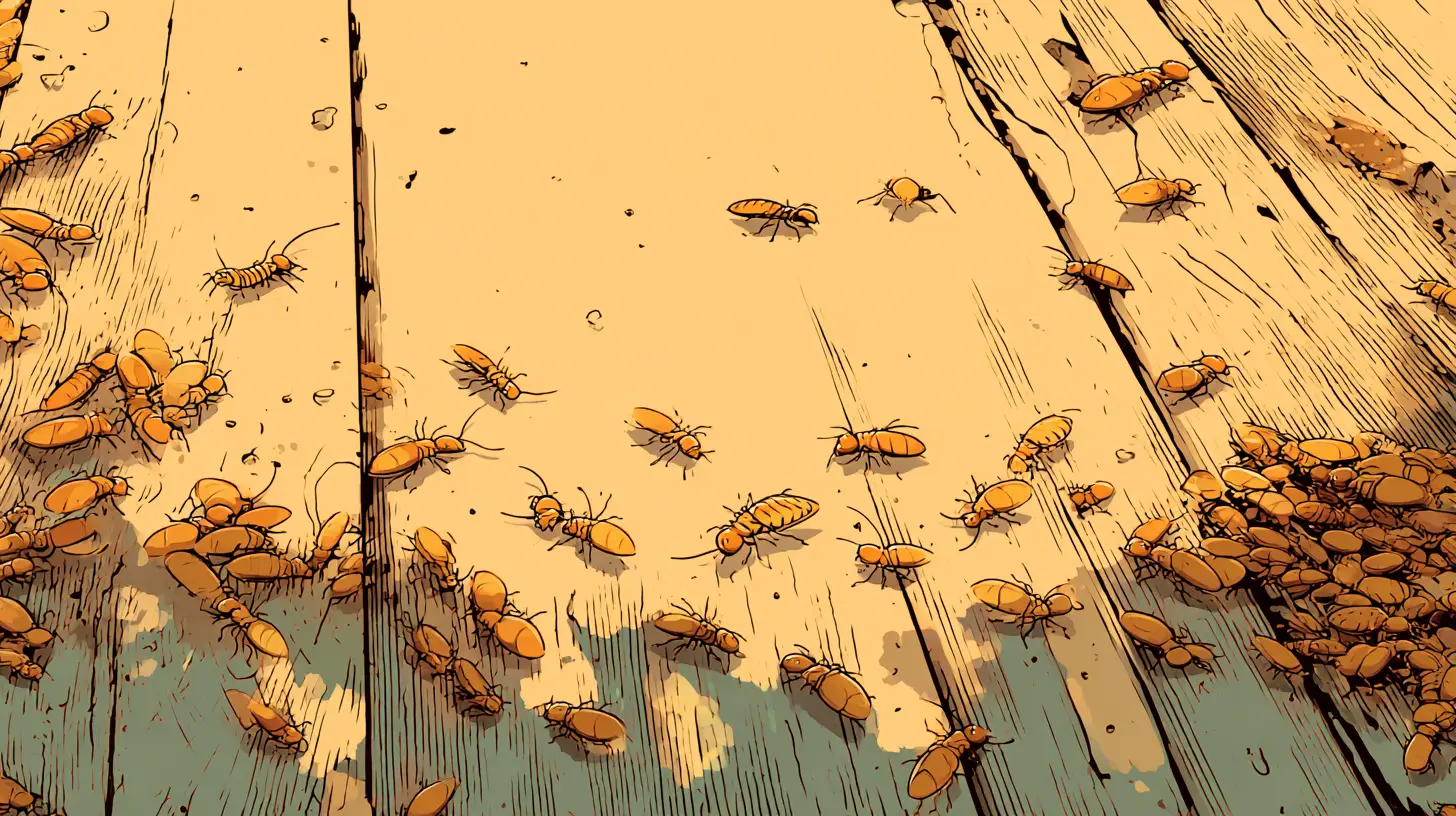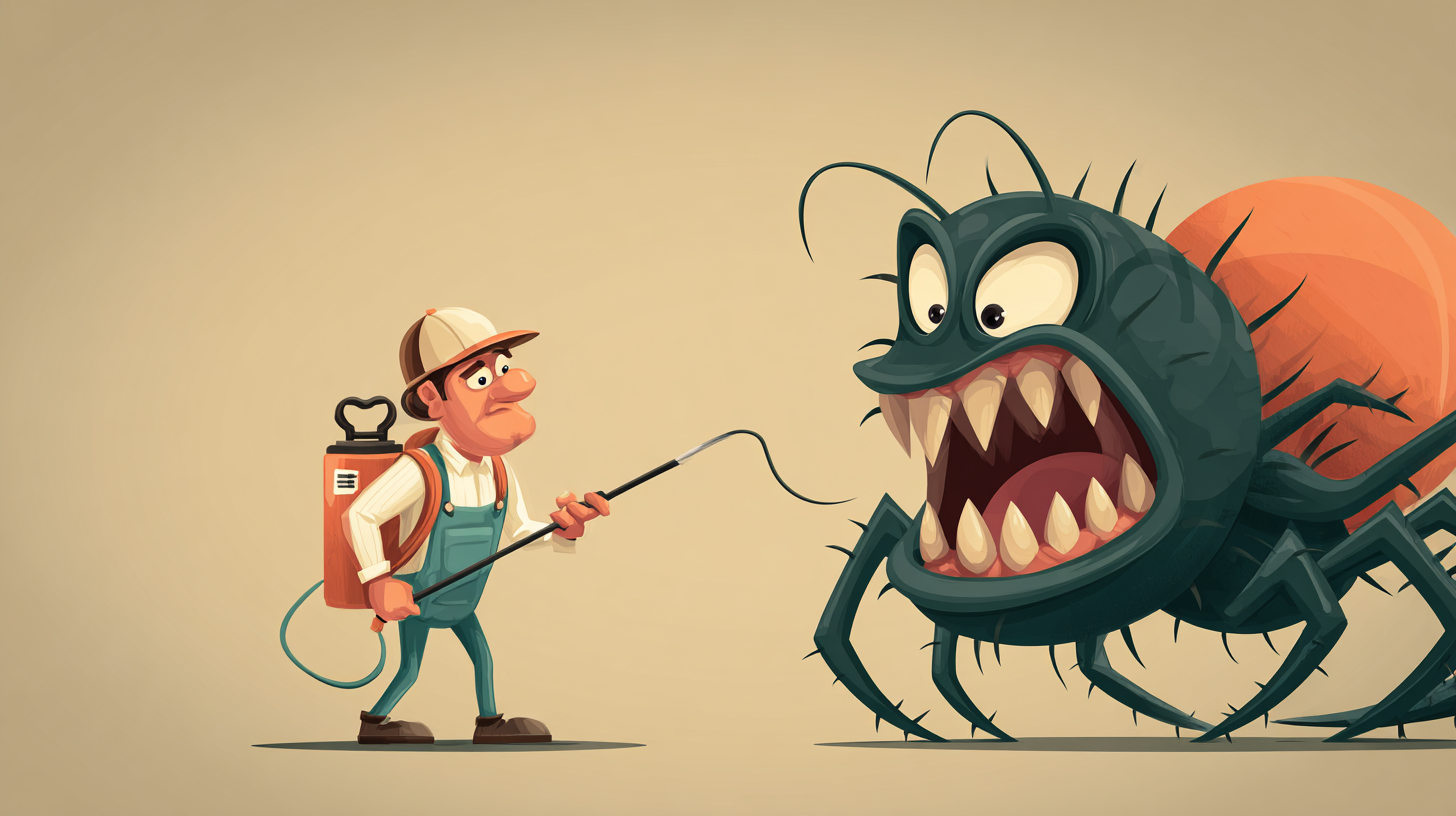
Table of Contents
Sarasota homeowners love their mulch – it’s the finishing touch that makes your flowerbeds pop and keeps the weeds down. But here’s a creepy little secret: that tidy layer of mulch around your Sarasota home might be hosting a secret bug party when you’re not looking. Mulch is everywhere in Florida landscaping, and unfortunately, it can double as the VIP lounge for a variety of pests. Before you shrug it off, go poke at that damp mulch by your shrubs one evening – don’t be surprised if something with antennae scurries out!
Key Takeaways
- Mulch is bug real estate — dark, damp, and full of cover. Roaches, ants, termites, and other creepy crawlers love it.
- Organic mulch (wood chips, bark, leaves) attracts way more pests than inorganic stuff like gravel or rubber.
- Too much mulch or mulch up against the house is like putting up a “Vacancy” sign for termites and roaches.
- Pine straw, cedar, or cypress mulch may help repel some bugs but won’t fix everything.
- Keep mulch 6–12 inches away from your home’s foundation and no more than 2–3 inches deep.
- Dry it out! Moist mulch = bug paradise. Adjust sprinklers, fix leaks, and rake the mulch regularly.
A handful of damp wood mulch – looks innocent, but it can hide a whole ecosystem of Florida bugs if you’re not careful.
In true Sarasota fashion, our heat and humidity turn mulch into a five-star resort for insects. Think about it: mulch stays moist, it’s nice and dark underneath, and it’s made of organic material. To bugs, that’s basically an all-inclusive spa package. So, what’s living in your mulch? Let’s dig in (not literally, unless you’ve got gloves on) and uncover the hidden pest havens lurking in those wood chips and pine bark around your home.
Mulch: The Backyard Bug Resort (Why Pests Love It)
Mulch does great things for your garden – it conserves soil moisture and adds curb appeal – but it also provides ideal conditions for many pests. The key is moisture and cover. Wood-based mulches (like bark, wood chips, or leaf litter) hold onto water and create a damp, sheltered layer that bugs adore. It’s basically a climate-controlled hideout: protected from the harsh sun, insulated from temperature swings, and close to the soil. In other words, mulch is a paradise for critters that thrive in moist, dark environments.
Not all mulch is equal in the eyes of pests. Organic mulches (anything made of once-living material) tend to attract bugs more than inorganic ones. If you’ve got wood chips or shredded bark mulch, those can be especially inviting – they retain moisture and even provide a little cellulose snack for wood-eating insects like termites. Leaf mulch or compost is even more of a buffet, since it’s already decaying and full of yummy organic matter. On the other hand, inorganic mulches like gravel, rocks, or rubber don’t break down or hold water like wood does, so they’re far less attractive as a bug condo. (Of course, even gravel can trap a bit of moisture underneath, but it doesn’t offer a menu of rotting wood for dinner.)
What about those fancy “pest-resistant” mulches you hear about? Some woods like cedar, cypress, or eucalyptus contain natural oils that help repel insects. Fresh cedar mulch, for example, gives off cedar oil (that lovely smell) which is known to turn away pests like certain ants and mosquitoes – at least until the oil dries up. Pine straw (pine needle mulch) is another option; it decomposes more slowly and its resin and lower pH seem to make it a bit less palatable to bugs. These mulches won’t send pests packing completely, but they might not harbor as many unwelcome critters as the cheap wood chips from last year’s tree trimming. The bottom line is, any organic mulch can become a pest haven if it stays damp and undisturbed. Knowing this, let’s meet some of the common culprits camping out in your mulch beds.
Meet the “Mulch Motel” Residents: Pests That Love Your Mulch
So who exactly is hanging out in that layer of wood chips by your hibiscus? Florida’s warm climate means a huge cast of creepy-crawlies could be in the mix. Here are the usual suspects using your mulch as their personal home-sweet-home:
- Cockroaches (Palmetto Bugs): Roaches don’t eat wood, but they love nesting in mulch. It’s dark, damp, and full of hiding spots – basically roach heaven. In Sarasota, the American cockroach (a.k.a. palmetto bug) often lives outdoors in decaying leaves and mulch. Flip over a wet clump of mulch or leaves and you might see them scurry away. If that mulch is right next to your house, those roaches don’t have far to wander before they sneak inside through a crack in your foundation or under a door. The last thing you want is these big “waterbugs” enjoying a spa day in your yard and then crashing your kitchen at night.
- Ants (and Carpenter Ants): Various ants build nests in mulch, but carpenter ants are a big concern. They don’t eat wood for food like termites, but they excavate moist wood and wood mulch to make galleries for their colonies. Wood mulch gives off an aroma (of tree sap/resins) that can actually attract carpenter ants looking for a cozy home. If your mulch is touching the house, ants can use it as a highway into your walls. Even non-carpenter ants appreciate mulch for the shelter – it’s cooler and damper there than the open ground, perfect for ant real estate.
- Termites: Ah, every Sarasota homeowner’s nightmare. Termites might find your mulch appealing, but not in the way most people think. Subterranean termites naturally live in soil and feast on wood. While mulch itself isn’t a guaranteed termite-magnet (they actually prefer solid wood over little mulch chips), a thick mulch bed can create the ideal conditions for termites to forage and not dry out. A layer of wood chips three inches or more deep holds moisture and keeps the soil underneath nice and damp – just how termites like it. If termites are already in the vicinity, a juicy mulch layer on the ground is basically an all-you-can-eat buffet spread out for them. Even mulch made from wood that termites don’t love to eat can serve as a bridge or hiding place for termites to cross over into your flowerbeds and, worst case, into your house’s structure. In short, mulch doesn’t attract termites from far and wide, but it can assist any that are nearby by giving them food and a safe pathway.
- Earwigs, Millipedes, and “Miscellaneous Creepy-Crawlies”: Those slender brown earwigs with the pincers on their bum? The hundred-legged wormy-looking millipedes? And let’s not forget their cousins, the centipedes, pillbugs (roly-polies), and sowbugs. Mulch is a magnet for all these moisture-loving critters. They are nature’s decomposers, chewing through decaying mulch and plant litter. In a way, they’re helping break down your mulch – great for soil, not so great when they start wandering onto your patio. Earwigs and millipedes won’t harm your house, but they can startle the heck out of you when you move a flower pot and dozens scatter. They usually stay hidden in the mulch by day and come out at night. If you’re seeing lots of them around your foundation or even finding some inside the house (earwigs love sneaking under door sweeps), your mulch might be hosting a few too many of these “friends.”
- Spiders: Where you have bugs, you get spiders – it’s nature’s rule. Mulch provides great hiding spots for spiders to lurk and build their webs. Most spiders in mulch are actually hunting the other pests (free pest control!), but if you’re not a fan of arachnids, note that mulch around the foundation can lead to more spiders near your home. They won’t eat the mulch, but they love the abundant insect buffet it harbors. And some of those spiders might eventually wander indoors, especially if their prey is doing the same.
- Mosquitoes: You might be thinking, “Mosquitoes breed in standing water, not in wood chips.” True – they’re not living in the mulch, but a pile of soggy mulch can hold enough moisture for mosquitoes to lay eggs if conditions are right. Water can collect in pockets of decomposing mulch or underneath it. Female mosquitoes only need a tiny bit of stagnant moisture to deposit dozens of eggs. So, consistently wet mulch (say, under an over-watered bed or a dripping faucet) can turn into a surprise mosquito nursery. Next thing you know, you’re slapping mosquitoes in your yard and wondering where they all came from. Mulch isn’t the top mosquito breeding source, but it can contribute if you let it stay swampy.
As you can see, your lovely landscaping mulch can play host to a whole crew of unwanted guests. But don’t rip all your mulch out just yet! The good news is, with a little know-how, you can have your mulch and keep pests at bay. A lot comes down to how you use and maintain your mulch. Let’s look at some common mulch mistakes that basically roll out the red carpet for pests (and how to avoid them).
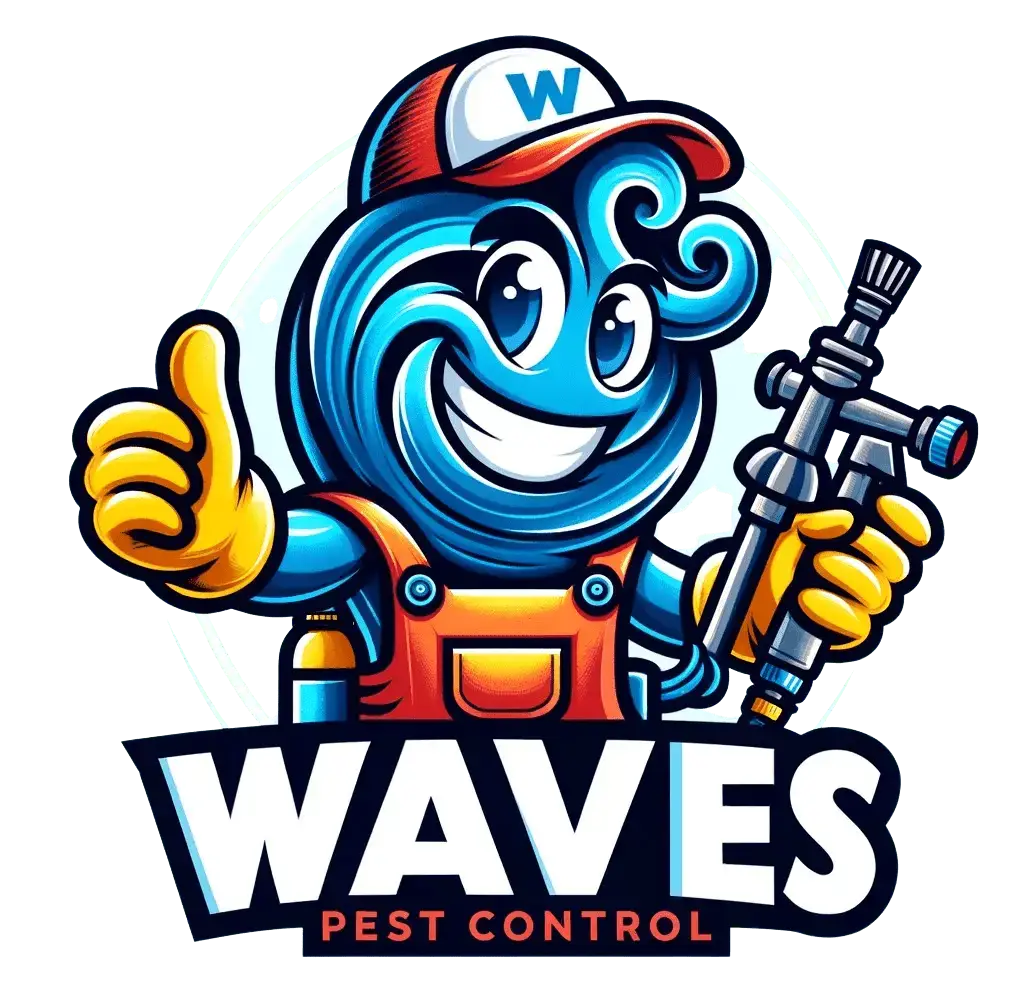
Get Pest-Free Today!
Trust Waves Pest Control for expert pest control in Sarasota, FL. Call now or request your free quote online!
Request a QuoteMulch Mistakes That Invite Pests (Are You Accidentally Feeding the Critters?)
Mulch itself isn’t evil – but how you place and care for it can mean the difference between a simple flowerbed and a full-blown “Mulch Motel” for pests. Here are some common mistakes homeowners make with mulch in Sarasota, essentially inviting pests to get comfortable:
- Piling Mulch Against the House: This is a big no-no, especially in termite country. It might look neat to have mulch snuggled right up to your exterior wall, but mulch touching your house is like a bug superhighway straight indoors. Termites can use that contact to bypass any treated soil and go directly from mulch to your foundation or siding, hidden from view. Roaches and ants also appreciate the cover – they can scuttle from mulch to a crack in your wall in seconds. Always leave a gap between mulch and the house. Experts recommend maintaining about a 6-inch bare zone or “inspection strip” next to the foundation. That gap of gravel or just exposed soil makes it harder for pests to sneak in and lets you spot termite mud tubes if they try. Mulch right up against wood or stucco is asking for trouble.
- Making the Mulch Too Thick: More is not better here. A thick cushion of mulch (anything over about 3 inches deep) stays wet and cool underneath – perfect for pests to breed. In fact, studies show termites survive better under thick mulch because it traps moisture and moderates the temperature. And a heavy layer of mulch can cover the foundation edge or block vents, hiding the evidence of termites or allowing them to build mud tunnels unseen. Keep your mulch layer moderate – usually 2 to 3 inches is plenty. If you really need deep mulch for weed control, do it farther from the house, not right next to the slab. Also, chunky mulches like larger bark nuggets can be better than fine ones; they allow more airflow and dry out faster than tightly packed shredded mulch.
- Keeping Mulch Soggy (Over-watering): Remember, moisture is the magnet for most of these pests. Some folks turn their sprinklers on and end up constantly soaking the mulch beds, or they plant flowers that need lots of water in the same bed. The result: perpetually damp mulch that screams “move in here!” to termites, roaches, earwigs – you name it. Florida building code actually requires that irrigation heads be at least a foot away from the house and not spraying the walls, largely because wetting the foundation and adjacent mulch creates prime termite conditions. Make sure your sprinklers are aimed properly and not misting your house or the base of your walls. Also, fix any leaky hoses or drip lines near your home’s perimeter. By keeping the mulch as dry as possible near the foundation, you discourage both termites and moisture-loving bugs. (Your plants will still get water from the soil – they don’t need mulch that’s dripping wet all the time.)
- Using “Soft” Wood Mulch or Unaged Mulch: Not all mulch is created equal. Fresh, unaged wood chips (like if you just chipped a tree) can sometimes attract pests more than aged mulch. They might contain more sap or sugars that certain insects detect. Also, mulch that includes a lot of sapwood (the lighter, softer part of wood) can be more appetizing to pests than hardwood or bark. For example, even cedar or cypress mulch, if it contains a lot of sapwood, won’t repel termites and ants the way the pure heartwood might. Using high-quality, aged mulch or naturally pest-resistant types can reduce issues. If you get free mulch from the city or tree companies, be aware it could be a mixed grab-bag of wood that might break down fast and lure bugs as it decomposes.
- Not Turning or Replacing Old Mulch: Mulch isn’t “set it and forget it.” Over time, it breaks down into rich organic matter – essentially compost – which is even more attractive to insects. Failing to rake or fluff your mulch periodically means the bottom layers stay perpetually moist and compacted, a perfect bug nursery. Every so often, take a rake and turn the mulch so the stuff on the bottom gets aired out and the top dries a bit. This also helps your mulch decompose evenly. Better yet, replace or top-up old mulch annually – but don’t just keep piling new mulch on top of old. If the old layer isn’t breaking down, scoop some of it out (especially if it’s matted or moldy) before adding more. Freshening up the mulch not only looks nicer but also disturbs any budding pest colonies and keeps conditions less hospitable for them.
By avoiding these mistakes, you take away a lot of what makes mulch attractive to pests. But what if you already have pests lurking, or you just want to be extra safe? Read on for some pro tips on managing mulch to strike the right balance – keeping the benefits for your plants and curb appeal, while evicting (or at least discouraging) the bugs.
Mulch Management 101: Pro Tips to Prevent Pest Problems
You don’t need to give up on mulch to avoid pests – just adopt some smart mulch habits. Here are some tried-and-true tips for Sarasota homeowners to keep mulch from becoming a pest vacation home:
- Give Your House Some Breathing Room: Always maintain a mulch-free border along your foundation – 6 to 12 inches of space between mulch beds and the house is ideal. You can fill that gap with gravel or stones if you want it to look finished, but keep it free of continuous wood or groundcover. This dry, clear zone makes it harder for termites and bugs to migrate from mulch to your walls, and it lets you spot any suspicious dirt tubes or ant trails easily. Think of it as a moat that pests have to cross in the open (most won’t dare).
- Aim for 2–3 Inch Mulch Depth, Max: When replenishing mulch, resist the urge to pile it high. Two to three inches is plenty to suppress weeds and retain moisture for your plants. Any deeper and you’re creating that damp lower layer pests love. If you notice existing mulch has compacted to a thin layer, it’s okay to top it up a bit – but if it’s built up too thick over the years, take some out. Remember, around the foundation and other critical areas, less is more. Even a thin 1-inch mulch layer near the house can do its job (preventing weed whacking and mud splash) without giving termites a cozy blanket to hide under.
- Choose Mulch Wisely (or Mix It Up): If pest problems persist, consider switching up your mulch type. Cedar, cypress, or eucalyptus mulches have natural insect-repelling properties and break down more slowly. They might reduce the number of bugs compared to plain wood chips. Pine straw is another good option – it’s airy, doesn’t hold as much moisture, and pests don’t seem to like it as much as dense wood mulch. You could also use inorganic material right against the house (say, a one-foot strip of gravel or shells) and put organic mulch further out. Many pest control pros suggest using rocks or rubber mulch near the foundation since they don’t feed pests or stay as damp. Just keep in mind you might trade one issue for another (rubber can get very hot, and rocks need weed fabric, etc.), but from a pest perspective, inorganic stuff is pretty unappealing to bugs.
- Mind the Moisture: We can’t control the Florida rain, but we can control our irrigation. Avoid daily watering of mulch beds – plants typically don’t need it, and you’re just keeping the mulch wet. Use a drip line or soaker hose under the mulch if you can, so the water goes into the soil and not on the wood surface. Fix any leaks promptly, and make sure water drains away from your home’s foundation. If you notice puddles forming in your mulch after rain, you may need to adjust the slope or drainage in that area. By reducing excess moisture, you make the mulch less of a luxury resort for termites and roaches – they like it humid, so let your mulch dry out between waterings. Bonus: drier mulch also discourages fungi and mold that attract other insects.
- Keep It Clean: Your mulch beds aren’t a storage area – don’t let piles of leaf litter, fallen fruit, or yard debris accumulate on top of the mulch. Decaying leaves and plant matter just add more fuel to the pest buffet (and can invite fungus gnats and flies too). Rake out debris periodically so the mulch layer is all that’s there. Also, try not to “store” pieces of wood, lumber, or firewood on top of mulch near the house – that’s like a neon sign for termites and carpenter ants. Landscape timbers used as borders can be a problem too, since they’re basically hunks of wood in contact with the ground (consider stone or recycled plastic borders as a pest-proof alternative).
- Inspect and Refresh: Take a little time every now and then to inspect your mulch areas. Lift a section of mulch and see what’s happening underneath. A few pillbugs and worms? That’s normal. But if you see large colonies of ants, clusters of roaches, or (heaven forbid) white termites or their mud tubes, you’ll want to intervene (more on that in a moment). If any patch of mulch seems overrun with critters, scoop it out into a bag and toss it – no sense leaving an active pest colony in place. When you add new mulch, you can even lay down a plastic or landscaping fabric barrier underneath it along the foundation line. This can help block insects from coming up into the mulch from the soil (though termites can still bridge over a barrier if determined, so don’t rely on this alone for termite prevention). Some gardeners treat their mulch with natural insecticides or repellents like cedar oil. That can provide a short-term deterrent, but it’s not a permanent fix – still, if you love the smell of cedar, a light spritz on your mulch won’t hurt!
By following these practices, you’ll make your mulch far less attractive to pests while still enjoying its benefits. You’ll have healthier plants, fewer creepy-crawlies, and better peace of mind. But what if you do all this and still find yourself battling a bug bonanza? That’s when it might be time to bring in the pros.
When to Call in the Pros (Termite Inspections and Pest Control)
Sometimes, despite your best efforts, the bugs win a few rounds. Maybe you’ve spotted the telltale mud tubes of termites sneaking up the side of your foundation, or you flip over some mulch and find a literal ant city underneath. Maybe those palmetto bugs are still making unwelcome guest appearances in your bathroom. When the pest situation has you overwhelmed or unsure, it’s wise to call a professional.
For instance, if you see any signs of termite activity – winged swarmers, tiny piles of sawdust-like frass, or those mud tunnels – contact a licensed pest control company immediately for a termite inspection. Termites are no DIY job; catching an infestation early can save you thousands in damage. A pro will know how to confirm if the colony is active and can recommend treatments (like a perimeter soil treatment or bait stations). Don’t wait on termites, because they won’t wait for you!
Likewise, if roaches, ants, or other pests are persistently coming from your mulch beds into the house, getting a professional treatment or ongoing service plan can make a world of difference. In Sarasota, many homeowners opt for quarterly or even monthly pest control plans to keep the bug population around their home in check. A skilled technician can apply safe insecticides around the foundation and in mulch beds to create a barrier that bugs won’t cross, keeping roaches and ants out of your living space. These aren’t the harsh, DIY bomb sprays that only kill on contact – modern treatments have residual effects that tackle the colonies at the source. Professional treatments are generally safer and more effective than store-bought remedies, and when combined with good mulch hygiene, you can keep the pests under control year-round.
So, when should you pick up the phone? Here are a few prompts:
- You’ve done the mulch management steps, but still see large numbers of pests (ants swarming, roaches galore, etc.) whenever you disturb the mulch.
- You find direct evidence of termites or carpenter ants near the house (don’t hesitate – get an inspection).
- You’re not sure what’s infesting your mulch, but something’s amiss – weird bugs you can’t identify, or damage to plants or wooden structures.
- You simply want the peace of mind that comes with a preventative pest control plan. It’s perfectly fine to have a pro check your property even if you haven’t seen a bug yet – they might spot conducive conditions you overlooked.
Bringing in a pro doesn’t mean you’ve failed; it means you care about protecting your home. A good pest control company will inspect your mulch, foundation, and yard, identify any pest issues, and tailor a treatment plan. They might suggest targeted services like termite control treatments, ant baiting programs, or a quarterly pest control service that keeps all the usual suspects (roaches, ants, spiders, etc.) at bay. Most offer free initial inspections or consultations – take advantage of that expertise, especially here in the pest paradise of Florida.
Mulch truly is a double-edged sword in Sarasota landscaping: it’s fantastic for your garden but can be a sneakily perfect pest haven if you’re not attentive. The goal is to enjoy the perks of mulch without inviting a bug takeover. By choosing the right mulch, placing it smartly, and keeping it dry and clean, you can significantly cut down on unwanted critters making a home in it. And if you do get a pest problem, now you know where one of the hiding spots might be – and that help is just a call away.
Keep an eye on that mulch, follow the tips, and you’ll turn your yard from “Mulch Motel” back into the beautiful landscape it’s meant to be – without the creepy tenants. Sleep a little easier knowing what’s (not) living in your mulch, and remember: a well-maintained yard is less likely to give you those horror-movie surprises when you go to plant the new petunias. Happy mulching, and may your only backyard guests be the butterflies!
Frequently Asked Questions (FAQs)
Can mulch cause a termite infestation?
Not exactly. Mulch doesn’t cause termites, but if they’re nearby, thick, moist mulch gives them the perfect conditions to tunnel up to your home unnoticed. Keep it shallow and away from the foundation.
What’s the best mulch to use in Florida if I’m worried about bugs?
Try pine straw, cedar, or cypress. They don’t eliminate pests, but they’re less attractive than basic wood chips. Gravel or stone is also a good call near your house.
How far should mulch be from my house?
Leave a mulch-free buffer of 6–12 inches. Use gravel or keep it bare. That space helps keep bugs out and lets you spot problems early.
What pests are most commonly found in mulch here?
Roaches (palmetto bugs), ants (including carpenter ants), termites, earwigs, millipedes, spiders, and sometimes even mosquitoes if it stays too wet.
Should I remove old mulch every year?
Yes, or at least rake and refresh it. Letting it pile up year after year turns it into decomposing mush — perfect for bugs to breed in.

